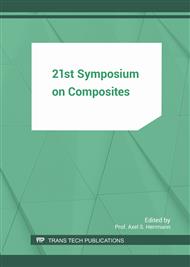p.381
p.389
p.395
p.401
p.408
p.419
p.427
p.434
p.440
Characterization of the Bonded Connection in Hybrid-Steel-GFRP-Laminates
Abstract:
Intrinsic hybrid laminates are well established since many years in aerospace engineering, e.g. Glass Laminate Aluminium Reinforced Epoxy (GLARE) is widely used as a substitute for aluminium sheets of the outer shell of modern aircrafts. The reduction of density and an increased stiffness by compounding glass fiber and aluminium makes GLARE advantageous. Driven by environmental protection acts and the need for lightweight design material compounds attract more awareness in the automotive engineering as well. Functional components like chassis springs are well predestined for the application of glass fiber reinforced plastics (GFRP). Therefore, an intrinsic hybrid made up by GFRP and a high strength steel has recently been developed and characterized. This investigation sets the focus on the interface between GFRP and steel. Double cantilever beam tests (mode I) and shear tests (mode II) are conducted in order to measure the energy release rate and the shear strength of the considered interface. A variety of surface treatments of steel layer has been characterized by this approach. The results show up that good adhesion can be achieved by silane and titanium dioxide primers, however, the variation within the data is significantly higher than for other surface treatment variants. Furthermore, the increase of the energy release rate by fiber bridging effects is considered as well and an approach for its quantitative description by a power law is presented.
Info:
Periodical:
Pages:
408-415
Citation:
Online since:
July 2017
Authors:
Price:
Сopyright:
© 2017 Trans Tech Publications Ltd. All Rights Reserved
Share:
Citation:


